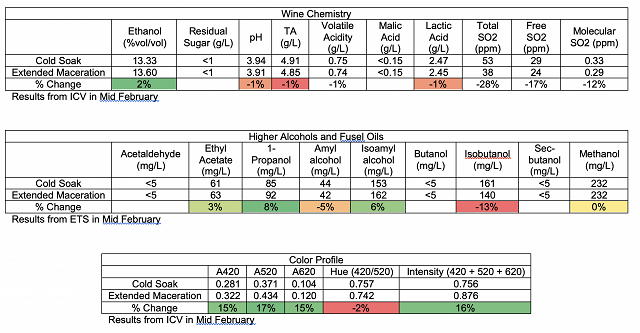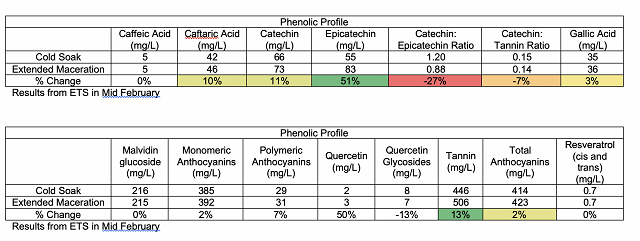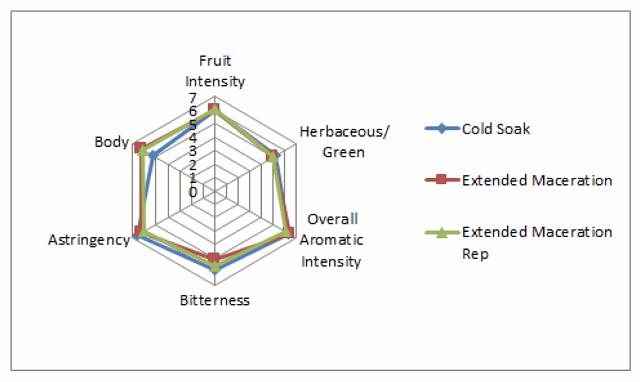The Impact of Cold Soak vs Extended Maceration in Petit Verdot Wine (2017)
Lee Hartman
Bluestone Vineyard
Summary
This study examines the impact of cold soaking vs extended maceration on Petit Verdot wine, with maceration time being equal between treatments. The goal was to have on treatment spend more time exposed to an aqueous phase, with the other treatment having more time exposed to an alcoholic phase. Petit Verdot grapes from the same vineyard block were harvested on the same day and destemmed into two separate T Bins. One T Bin underwent a 4 day cold soak prior to inoculation, whereas the other was immediately inoculated without cold soak. Both treatments underwent a 25 day maceration before being pressed off on the same day: thus, the cold soak received less time in contact with must in an alcoholic phase. All other treatments between wines were identical. Wine chemistry and ester profiles were not much different between treatments. The extended maceration treatment had higher levels of color, epicatechin, and tannin, but other phenolic compounds were not much different. The wines were not found to be significantly different via triangle testing. However, there was a strong trend for the cold soak wine to have higher Astringency than the extended maceration wine. There was a slight tendency for this wine to have increased Bitterness and lower Body as well. The total maceration time for these wines was long in both cases, and as such the differences seen here may be greater if smaller overall maceration times are used. In the future, this should be performed, and more microbial analysis should be performed as well.
Introduction
Skin contact with fermenting juice has complex equilibrium interactions involving extraction into juice and adsorption onto solids of phenolic and aromatic compounds. This relationship is further complicated in that the physical integrity of grape cellular components degrade over time. For example, the release of anthocyanins from hypodermal vacuoles involves rupture of the cell membrane and vacuole. This process can be impacted by ethanol, heat, carbon dioxide, and sulfur dioxide. However, ultimate collapse of cell membranes instead of merely rupturing them may prevent release of these compounds into the juice (Sacchi et al. 2005). The degradation of grapes can also result in higher levels of insoluble solids in the fermentation, which may adsorb anthocyanin and other compounds and reduce color. Thus, equilibrium dynamics between solid and juice phases change throughout the fermentation. For example, anthocyanin concentration tends to peak early and then decline as fermentation continues (Berg and Akiyoshi 1956; Kovac et al. 1992; Sacchi et al. 2005). This is likely not due to limited solubility, but instead due in part to instability and formation of polymeric pigment. (Kovac et al. 1992; Sacchi et al. 2005). Additionally, extended maceration often lowers color intensity and anthocyanin concentration (Casassa et al. 2013a, 2013b, 2013c; Yokotsuka et al. 2000; Casassa et al. 2016), which suggests that anthocyanin adsorb onto skins and other insoluble solids which increase during extended maceration.
Cold soaking is often a way to increase the contact time of wine in an aqueous phase, as opposed to extended maceration which results in more contact time in an ethanol-rich phase. Cold soaking extracts anthocyanin and skin tannin, but not much seed tannin (since efficient seed tannin extraction requires ethanol). Thus, cold soaking may produce a wine with less seed tannin, because it might allow for the winemaker to reduce maceration time in the presence of ethanol. However, the impact on color is variety-dependent and inconsistent. For example, Pinot noir often loses color from cold soak, whereas Cabernet Sauvignon tends to gain color from cold soak. There does not seem to be much benefit from cold soaking beyond 3 days (Zoecklein 2007). Other authors have found that, in general, cold soaking does not enhance color or phenolic content of wines; if anything, it will sometimes decrease color and phenolic intensity (Sacchi et al. 2005).
Seed extraction occurs with increasing ethanol concentration due to the dissolution of the seed coat by ethanol. Thus, stem and skin tannin are extracted for the first 5-7 days of fermentation before seed tannins begin to be extracted (Zoecklein 2007). Increasing maceration time can increase tannin and anthocyanin content in wine, but this depends on the length of time. Extended maceration generally only increases tannin content from skins and seeds (Berg and Akiyoshi 1956; Zoecklein 2007). The formation of polymeric pigment is often enhanced by longer maceration times, especially at low pH (Sims and Morris 1985; Scudamore-Smith et al. 1990). This increase in polymerization may help soften the mouthfeel of wines (Zoecklein 2007), although this must be balanced with increasing seed tannin extraction from longer maceration times.
The purpose of this study is to compare macerating Petit Verdot grapes for the same amount of time, but in one treatment having a longer aqueous phase whereas in the other treatment having a longer alcoholic phase.
Results and Discussion
Wine chemistry and ester profiles were not much different between treatments. The extended maceration treatment had higher levels of color, epicatechin, and tannin, but other phenolic compounds were not much different. This is to be expected from an alcoholic phase promoting greater extraction of phenolic compounds and tannin. The higher alcohol and fusel oil sample was contained in plastic bottles, which may have impacted results.


For the triangle test, of 10 people who answered, 5 people chose the correct wine (50%), suggesting that the wines were not significantly different. Of those who answered correctly, 4 preferred the extended maceration wine, and one had no preference. This preference trend, however, is weak due to the low number of judges. For the descriptive analysis, there was a strong tendency for the cold soak wine to have higher Astringency than the extended maceration wine (LSD=0.25). There was a slight tendency for the cold soak wine to have higher Bitterness and lower Body as well.

The total maceration time for these wines was long in both cases, and as such the differences seen here may be greater if smaller overall maceration times are used. In the future, this should be performed, and more microbial analysis should be performed as well.
Methods
Petit Verdot grapes from the same vineyard block, with homogenous soil, slope, drainage, ripening kinetics, etc. were picked and destemmed on the same day into 2 separate bins. At processing, 100mL Color Pro and 30g/hL FT Rouge were added. One T Bin was then put in cold storage at 40°F for 4 days for cold soaking, then moved outside to warm up and was inoculated with D80. The other T Bin was immediately inoculated with D80, with no cold soak. Both were fermented for a total of 25 days on the skins, then pressed off (only free run was used). Thus, one treatment received 4 days more of cold soak, whereas the other treatment received 4 days more of extended maceration. The goal was to have one treatment to spend more time exposed to an aqueous phase, while the other treatment to have more time exposed to an alcoholic phase. All other treatments were identical. Both were then inoculated with VP41 malolactic culture after pressing.
This project was tasted on April 4. For the triangle test, descriptive analysis, and preference, anybody who did not answer the form were removed from consideration for both triangle, degree of difference, and preference. Additionally, anybody who answered the triangle test incorrectly were removed from consideration for degree of difference and preference. Additionally, any data points for preference which did not make sense (such as a person ranking a wine and its replicate at most and least preferred, when they correctly guessed the odd wine) were removed.
In order to balance the data set to perform statistical analysis for descriptive analysis, any judge who had not fully completed the descriptive analysis ratings were removed. In order to then make the number of judges between groups equivalent, one judge from group 2 was eliminated. This resulted in a final data set of 3 groups, each with 3 judges (considered as replications within groups, and groups were considered as assessors). Data was analyzed using Panel Check V1.4.2. Because this is not a truly statistical set-up, any results which are found to be statistically significant (p<0.05) will be denoted as a “strong trend” or a “strong tendency,” as opposed to general trends or tendencies. The statistical significance here will ignore any other significant effects or interactions which may confound the results (such as a statistically significant interaction of Judge x Wine confounding a significant result from Wine alone). The descriptors used in this study were Fruit Intensity, Herbaceous/Green, Overall Aromatic Intensity, Bitterness, Astringency, and Body.
References
Sacchi, K.L. Bisson, L.F., and Adams, D.O. 2005. A review of the effect of winemaking techniques on phenolic extraction in red wines. Am. J. Enol. Vitic. 56:197-206.
Berg, H.W. and Akiyoshi, M. 1956. The effect of contact time of juice with pomace on the color and tannin content of red wines. Am. J. Enol. Vitic. 7:84-90.
Kovac, V., Alonso, E., Bourzeix, M., and Revilla, E. 1992. Effect of several enological practices on the content of catechins and proanthocyanidins of red wines. J. Agric. Food Chem. 40:1953-1957.
Casassa, L.F., Beaver, C.W., Mireles, M., and Harbertson, J.F. 2013b. Effect of extended maceration and ethanol concentration on the extraction and evolution of phenolics, colour components and sensory attributes of Merlot wines. Aust. J. Grape Wine Res. 19:25-39.
Casassa, L.F., Beaver, C.W., Mireles, M., Keller, M., Riley, W.R., Smithyman, R., and Harbertson, J.F. 2013c. Sensory impact of extended maceration and regulated deficit irrigation on Washington State Cabernet Sauvignon wines. Am. J. Enol. Vitic. 64:505- 514.
Casassa, L.F., Beaver, C.W., Mireles, M., Larsen, R.C., Hopfer, H., Heymann, H., and Harbertson, J.F. 2013a. Influence of fruit maturity, maceration length, and ethanol amount on chemical and sensory properties of Merlot wines. Am. J. Enol. Vitic. 64:437- 449.
Casassa, L.F., Larsen, R.C., and Harbertson, J.F. 2016. Effects of vineyard and winemaking practices impacting berry size on evolution of phenolics during winemaking. Am. J. Enol. Vitic. 67: 257-268.
Yokotsuka, K., Sato, M., Ueno, N., and Singleton, V.L. 2000. Colour and sensory characteristics of Merlot red wines caused by prolonged pomace contact. J. Wine Res. 11:7-18.
Zoecklein, B. 2007. Grape and wine Color and tannins: The ties that bind. Vineyard and Winery Management. Jan/Feb:61-68.
Scudamore-Smith, P.D., Hooper, R.L., and McLaran, E.D. 1990. Color and phenolic changes of Cabernet Sauvignon wine made by simultenous yeast/bacterial fermentation and extended pomace contact. Am. J. Enol. Vitic. 41:57-67.
Sims, C.A., and Bates, R.P. 1994. Effect of skin fermentation time on the phenols, anthocyanins, ellagic acid sediment, and sensory characteristics of red Vitis rotundifolia wine. Am. J. Enol. Vitic. 36:181-184.
